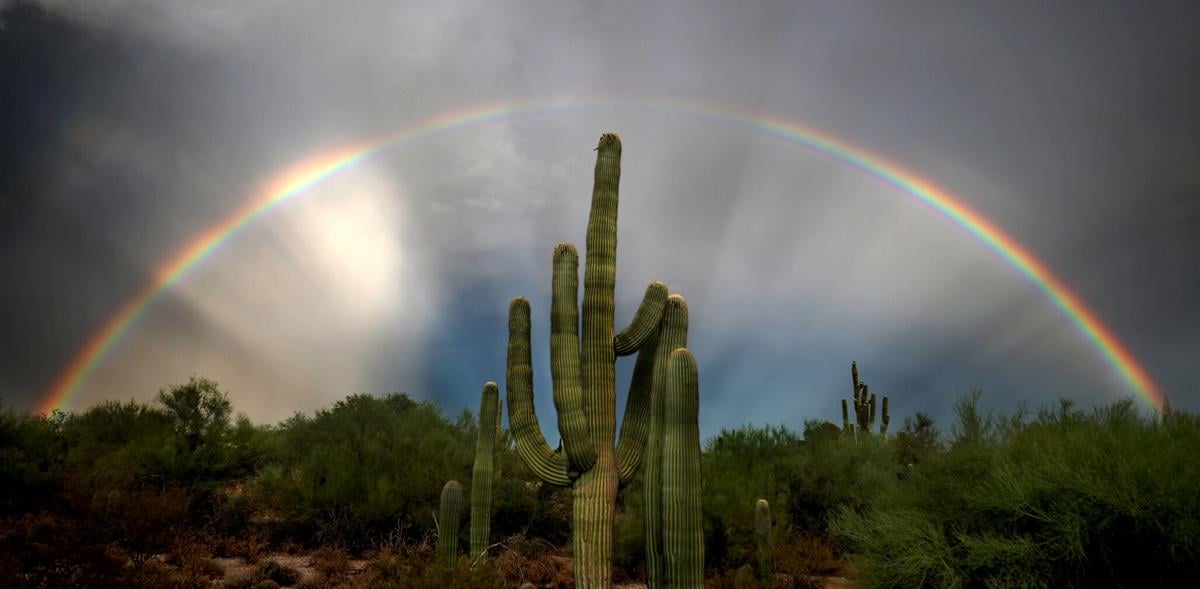Tucson boiled over once more in 2023, with average daily temperatures finishing tied for the third warmest year on record.
It was also the year of the split weather personality, with temperatures well below normal from January through June but soaring well above normal from July through December. The spike gave Tucson its hottest second half of of the year on record since the National Weather Service started keeping records here in 1895.
Moreover, it was the 25th consecutive year in which Tucson temperatures came in above average. Nine of the warmest 10 years on record here have come since 2009.
Overall, 2023's annual average temperature of 71.2 degrees tied with 2014 and 2015 as the third warmest year on record.
Temperatures particularly skyrocketed in July, when both Tucson and Phoenix recorded their warmest months on record. Every day of Tucson's July reached at least 100, which had only happened once before for any month.
For the entire world, 2023 was the hottest year on record, a NASA official told USA Today.
Climate change, urban heat island
Traditionally, local climate scientists have cited two causes for Tucson's continuously warming temperatures. One is global climate change, which an overwhelming majority of climate scientists have blamed on the burning of fossil fuels such as oil, coal and natural gas.
The other is the urban heat island effect, in which increasing pavement, sidewalks, construction of buildings and bridges and other forms of urban and suburban growth add to the amount of impermeable materials that radiate heat back into the atmosphere.
"Undoubtedly" both of these forces were at play in Tucson's 2023 temperatures, said Gregg Garfin, a longtime University of Arizona climate scientist.
"Living in an urban area we cannot escape the effects of heat retention by the built environment, including buildings and pavement, as well as exhaust heat from air conditioners and automobiles," said Garfin, professor and extension specialist at UA's School of Natural Resources and the Environment.
Regional temperatures continue to increase, due to global warming, based on ongoing monitoring by the National Oceanic and Atmospheric Administration and from evidence in scientific studies and the recently released 5th National Climate Assessment, Garfin added.
For example, for the Southwest region, the latest National Climate Assessment mentions increases in the number of days with maximum temperatures greater than 95 Fahrenheit and in the number of days with minimum temperatures greater than 70 Fahrenheit, Garfin said.
55th driest year
As for rainfall here, it was less but not dramatically less than normal. In 2023, Tucson got 10.21 inches, or four-tenths of an inch below normal. That made 2023 the 55th driest year on record for Tucson. The summer monsoon season was the 39th driest on record, with 4.73 inches of rain.
The weather year's most striking development was the abrupt change in warmth after June 30th.
From Jan. 1 through that day, Tucson's daily temperature averaged 66 degrees, or 1.2 degrees below normal. From July 1 through December, the daily average was 78.2 degrees, or 4 degrees above normal.
"It's hard to say" what was the root cause of the sudden temperature shift, said Aaron Hardin, a National Weather Service forecaster in Tucson.
But in the first half of 2023, Tucson had a more active weather pattern, with more low pressure weather systems keeping the air cooler, Hardin said.
During the summer, a ridge of high pressure built up over Tucson and much of Arizona, raising temperatures and keeping many monsoon storms away, he said. In a good monsoon year, the high pressure ridge heads north to the Four Corners area, allowing more moisture and monsoon rains to arrive from Mexico, he said.
Looking ahead, for Tucson, the National Weather Service predicts 60% to 70% chances of below normal temperatures in January and 40% chances of above normal precipitation for January, Hardin said. For the entire three-month period through March, the outlook is for equal chances of above and below normal temperatures and precipitation, he said.
Our patterns mirrored Phoenix's
Weather patterns were very similar although more extreme in Phoenix. That city finished 2023 with its fourth-warmest year on record.
But the period January through March was the coolest such period in Phoenix since 2000, said Gabriel Lojero, a Weather Service meteorologist there. While June was also cooler than normal there, "the weather pattern changed drastically in July.We got no relief from extreme heat. We didn't get the sufficient moisture to help us with thunderstorm activity," Lojero said.
As for rain, "we were doing really well with rain through March. Then we went into a really dry streak, with over 140 consecutive days without measurable precipitation" at Phoenix Sky Harbor Airport, he said.
For the year, Phoenix had only 4.21 inches of rain, about three inches below normal.
See what today's weather forecast looks like in Tucson.





